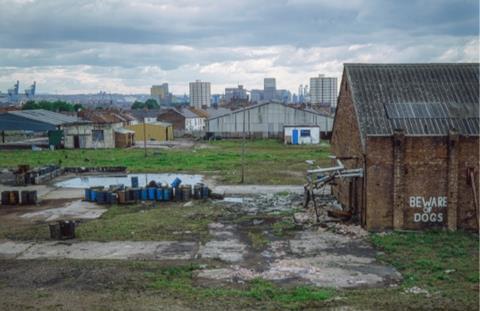As the political parties gear up for a general election, Housing Today publishes a number of key recommendations to shape the debate about how to boost housebuilding


The Building the Future Commission, in collaboration with Housing Today’s A Fair Deal for Housing campaign, has spent the last year looking in detail at the state of the housing developement sector, asking key sector figures where the innovation will come from, and what exactly needs to change to get it in better shape.

The commission, launched by Housing Today’s sister title Building, has delivered an in-depth review of the English planning system, and led the wider public policy debate, such as by floating the idea of a planning super squad – months before Michael Gove announced the very same thing.
Housing Today’s A Fair Deal for Housing campaign, which urges the government to recommit to its 300,000-home manifesto pledge, has for the past 18 months sought ideas from across the sector on how to boost development.
These efforts have left us in a good place to look back and suggest some ideas to boost delivery in the run up to the general election and beyond.
Our recommendations come as the residential development industry sits at a low point, pondering an uncertain future.
Mainstream housebuilders are contemplating major reductions in output in 2024 following the mortgage market challenges since the Truss-Kwarteng mini-Budget, with one former top 30 firm, Stewart Milne, already throwing in the towel this year.
But it’s not just housebuilders – housing associations and build-to-rent developers too have been hit by the increasing cost of capital and are finding it harder to build, with registered providers already hamstrung by a raft of other regulatory challenges.
As if that wasn’t enough, a brutal 2023 has left hopes of a volumetric modular housebuilding renaissance, carefully nurtured over the last decade, hanging by a thread, with the collapse of the most high-profile start-ups. It’s fair to say the residential development sector feels in need of some support – and some change.
Here, then, is the Building the Future Commission’s and Housing Today’s ideas for reforms of the housing and planning space.
State of the nation
It might be considered a somewhat tired cliché to describe the UK housing market as dysfunctional – but that doesn’t make it untrue. In the last year the status of homes as a prized financial asset beyond being simply a place to live has continued to distort the market and fuel buyer demand, even as rising mortgage rates have made purchasing – for most – vastly more expensive and caused developers to rein in their build programmes.
Despite recent (modest) falls in house prices, the barrier to entry for first time buyers entering the market – with homes now worth an average of 8.1 times annual earnings in England – has pushed the mean age of purchase up by two years in just a decade, according to Lloyds.
The rate of home ownership in England has once again started to decline, falling to 64% in 2021/22 – seven percentage points down on two decades earlier. Meanwhile, more than 1.2 million people languish on local authority waiting lists for affordable housing, while rents in the UK private sector soared by 6.2% in the last year – the biggest increase since at least 2016.
>> See also Top 50 Housebuilders 2023: The calm before the storm
>> See also UK housebuilding recession: How much worse is it going to get?
Buying has been put further out of reach by the failure so far of house prices to fully adjust for the higher interest rate environment. The continuing presence of cash buyers, alongside well-capitalised developers who see no need to drive up build rates to bring in cash, and the lack of forced sellers in the market, mean there are few drivers forcing a downward correction in prices.
Ultimately it suits the builders better to avoid costly write-downs courtesy of big house price falls that would only damage their balance sheets. Recent reductions in interest rates will provide some welcome relief, but leave rates still well above the level of two years ago.
The result is a depressing stalemate, one in which current high house prices are largely preserved only by a scarcity of homes for sale – both new build and second hand. Transaction levels are forecast by Savills to have fallen 16% to just 870,000 last year, ensuring a big fall in the build volumes which are required to ultimately tackle housing need.
Other developers are in no shape to step in, with registered providers labouring under huge pressure to invest in their existing stock before creating new homes, and even the build-to-rent sector and ‘for profit’ providers struggling with the higher cost of capital impacting on viability. The government has given no indication it is considering stepping in to boost build rates.
The Construction Products Association predicts a 20% drop in output between 2023 and 2024, with not even a sniff of a recovery until 2025. This is the latest iteration of a boom-and-bust cycle in residential property development that ultimately damages the industry and serves to reduce the capacity of the sector to deliver the homes people need.
The last decade has seen the industry pumped up by demand-side stimulus in the form of Help to Buy and, latterly, temporary Stamp Duty relief, only to have the stimulus removed now, just at the point mortgage rates have risen to a level that would suggest people need more help getting on the ladder.
Unsurprisingly, last year was punctuated by announcements of redundancies and restructuring at major builders, and the collapse of some well-known firms.
The evidence suggests that repeatedly ramping up build rates – as was seen in the two years following the covid crisis, for example – and then pulling back on development, simply denudes the industry of skilled staff it needs to rely on, as talented people find more dependable work elsewhere. The question is what to do about all this.
Recommendation 1: Measures to significantly boost the supply of affordable housing
By building more affordable homes in high demand areas, a huge difference can be made to those most in need, as well as to the overall delivery total. The last eight years has seen England deliver an average of just over 50,000 affordable homes a year, around 70% of which have been for rent, with commonly just under half funded by developers through planning contributions. This compares to an assessed need for affordable housing, according to a landmark Heriot Watt study for housing charity Crisis and the National Housing Federation, of 145,000 affordable homes per annum.
Boosting affordable supply would both help those with the most acute housing problems, as well as assist in retaining and/or boosting capacity in the residential development sector. Affordable housing supply can be used to boost housing delivery during periods of market downturn, so public money can act in a counter-cyclical manner to even out the boom-bust nature of the housing market cyclical, as per the recommendations of the Redfern Review.
The government has a £11.5bn programme of investment already laid out into affordable housing, designed to deliver up to 180,000 housing starts between 2021-26.
However, both the National Audit Office and the department’s own analysis suggest that given construction inflation, market factors and pressure on social landlords, the programme is at severe risk of not meeting its targets.
While those administering the programmes – Homes England and the GLA – have indicated their willingness to be flexible in the current environment, there has been no major review of the programme and no additional funding, despite widespread reports of housing associations reducing their development plans.
Last summer the Department for Levelling Up, Housing and Communities admitted it had been forced to hand back £255m of the homes programme cash to the Treasury because it had been unable to spend it.
The Building the Future Commission recommends the government commissions an immediate review with the aim of identifying how to significantly increase affordable housing output, to closer to 100,000 homes a year. While not being prescriptive on outcomes, this review should specifically consider:
- Reviewing the existing funding settlement for affordable housing; and specifically how much more funding might be needed to deliver a more ambitious programme. The Chartered Institute of Housing has estimated that £700m would be needed per annum for every 10,000 additional homes
- The need for a time-limited stimulus package, responding to the current issues in the market caused by the high cost of private funding, weakened housing association finances, and the competing priorities for HA spending to deliver more affordable homes. The Housing Forum has estimated a £3bn package could deliver 45,000 rented homes. This could have the benefit of also unlocking stalled and/or slowed developments if appropriately structured
- A longer-term rent settlement for affordable housing predicated on a greater level of capital investment
- Government stepping in to underwrite loans to the sector to reduce the cost of capital and improve scheme viability
- A review of mechanisms that might be needed to lever in more institutional finance to the private ‘for profit’ housing sector
- Looking specifically at grant rates for the affordable housing programme, and whether the current programme has sufficient flexibility to deal with the current financial situation
Recommendation 2: Measures to boost private sector housing supply
Housing supply increased sharply in the 2010s in the wake of the creation of the Help to Buy equity loan scheme, and official figures say it has so far held fairly steady, with net additions of 234,000 new homes in the last full year, to March 2023. However, given adverse market conditions, all the indications are that completions will fall sharply in the current year, with the NHBC recording completions in the third quarter of 2023 as 15% down on 2022, with starts a huge 57% down.
Private housebuilders are suffering from a combination of higher mortgage rates, making their products more expensive to mortgaged buyers, and from the withdrawal of the Help to Buy scheme, which was finally axed at the end of 2022.
However, government should resist the temptation of the sugar rush boost potentially provided by a re-introduction of a demand-side stimulus such as Help to Buy. While Help to Buy, which between 2013 and 2022 funded the purchase of over 387,000 new-build properties at a cost of nearly £25bn, undoubtedly helped both the individual buyers who benefitted and the housebuilding industry itself, many economists make the argument that the impact on the housing market as a whole was inflationary – and therefore hurt many more people than it helped.
A 2020 House of Lords committee report found that the scheme “inflates prices by more than its subsidy value in areas where it is needed the most”. As former No10 housing adviser Toby Lloyd says: “We’ve got to stop trying to tackle a housing problem which is essentially one of high housing prices with measures that inflate prices.”
While the government could use demand side measures to incentivise particular types of purchases – such as through the introduction of green mortgages, which would favour energy-efficient new build homes – policy should overwhelmingly focus on boosting supply.
The Building for the Future Commission recommends the government should therefore consider the following:
- Implement the recommendations of Letwin review of Build Out, to ensure more rapid delivery of permissioned sites, particularly focusing on measures to ensure diversity of tenure, type and developer on large sites
- Consider more broadly how to develop a stronger model for developing large sites, urban extensions and new towns, taking advantage of well-funded public-interested organisations, such as development corporations, with a strategic vision and powers to drive development
- Utilise Homes England’s procurement to boost SME housebuilding by subdividing sites into plots suitable for smaller firms. In addition, consider how Homes England might support new entrants in to the housebuilding sector, such as local authorities, build-to-rent developers and ‘for-profit’ registered providers
- Consider amending the definition of “small sites” in planning policy (currently 10 units) in order that builders beyond simply micro-enterprises can benefit from local planning policies designed to benefit small firms
- Take forward the “Street Votes” proposals alongside other initiatives for suburban intensification as a matter of priority in order to boost SME builders and deliver higher levels of in-fill development
- Bring forward plans to prompt lenders to offer green mortgages for energy efficient houses. These should reward housing with an EPC A or B ratings (primarily new build). Work should also be done to create a ‘retrofit’ version, under which beneficial mortgage terms are offered on the basis of agreements to undertake green retrofits to existing homes immediately subsequent to purchase
Recommendation 3: Measures to boost brownfield regeneration and estate redevelopment

Despite a stated government aim to prioritise brownfield development, the proportion of development taking place on brownfield land has dropped considerably in the last 15 years following changes of government policy, including planning changes and the axing of former New Labour funding streams designed to encourage regeneration. In 2021/22 (the most recent data) 54% of homes were built on brownfield sites, compared to a peak of 81% in 2008.
Estate regeneration is a huge opportunity to boost the living environments of people in some of the most deprived parts of the country, while delivering quality new affordable and market housing and urban intensification.
However, many such schemes are struggling with viability and the competing priorities facing housing associations in the current environment, and the sector has also been particularly hard hit by continuing uncertainty regarding new requirements that residential buildings of 18 metres or higher must include a second staircase, which have seen plans for thousands of homes stall.
Current funding streams designed to incentivise major projects and regeneration have proved unfit for purpose in the current inflationary environment, with DLUHC admitting early this year that the £4.2bn Housing Infrastructure Fund has spent just £1.3bn since being created in 2017. Industry insiders say the scheme expected bidders – often private consortiums – to deliver against far too tight deadlines, before being too slow itself to make decisions, and not flexible enough to cope with the impact of high construction cost inflation.
Industry figures, such as BtFC commissioner Andy Hill, founder of housebuilder Hill, say the government should consider targeted incentives in the form of tax breaks to make brownfield development pay.
The Building for the Future Commission recommends that the government consider the following measures to boost both brownfield development and estate regeneration.
- Review and revise existing government funding for infrastructure to support major housing schemes to ensure they are fit for purpose. Funding streams must work on a continuous rolling basis (rather than be one-off), give reasonable deadlines, make decisions in reasonable timeframes, and be flexible enough to adapt to changing market conditions
- If necessary, consider bringing forward additional funding pots, administered by Homes England, designed to bridge the gap for brownfield schemes with marginal viability, with a particular focus on enabling infrastructure
- Review what specific government measures could be taken to encourage brownfield and estate renewal and redevelopment schemes, including potential tax incentives for developers investing in brownfield schemes. Hill Group, for example, has suggested offering 100% tax relief on housebuilders investing an industry-funded first time buyer scheme, such as First Buy, which could target flatted developments or brownfield schemes, making them more profitable.
- Undertake a full cost-benefit analysis of the need for a second staircase in residential properties, given the current impact on estate renewal projects
Recommendation 4: Measures to reform the planning system
The planning system is widely recognised as being in a slow-moving crisis, with permissions falling to historic lows as councils have abandoned plan-making efforts in the wake of crippling government policy uncertainty.

This policy uncertainty has been compounded for over a decade by severe public sector funding austerity, which has left many council planning departments without sufficient resources to undertake the work necessary to navigate an increasingly complex system. Just 15% of major planning decisions are now taken within the requisite 13 weeks.
At the heart of the current policy uncertainty lies an ongoing debate about how councils calculate the number of houses they have to build in their areas, and how – or even whether – to account for those homes which can’t be accommodated within the council boundary.
The Building the Future Commission undertook an extensive consultation process over 2023 to attempt to come up with a way forward for the existing system – with the aim of producing a blueprint that didn’t simply result in years and years of hiatus as councils and developers adjusted. The result was the Building the Future Commission’s report in to the English Planning System, published in September. Its principal recommendations were:
- Properly resourcing the planning system, including by giving councils the power to raise fees to a level that allows for full cost recovery on the processing of applications, across all application types. Government should bring forward the promised sector skills strategy without delay
- Ensuring that local plans are put in place, by pressing ahead with reforms already in train to speed up the process of local plan-making, such as by instituting a 30-month time limit for plan preparation and streamlining plan content and evidential requirements. The government should go further, by revisiting the formulation of the “presumption in favour of sustainable development” in national policy to give this back its prior force in incentivising local plan production
- Reinstate a strategic planning tier to take key decisions, such as on housing numbers and green belt where it most makes sense. In order to avoid problems with local development constraints (such as green belt and Areas of Outstanding Natural Beauty) leading to local housing need not being met, a strategic tier to the planning system should be formed from existing sub-regional bodies, such as combined authorities and/or groups of county authorities. These would take “larger than local” decisions about housing numbers for individual authorities, and strategically review green belt where necessary
- Simplifying and standardising the system of planning contributions, but ditching plans to introduce the widely opposed Infrastructure Levy. The existing system of Section 106 and the Community Infrastructure Levy could be made to work more efficiently through proper resourcing of planning, and standardising the s106 legal agreement.
For the full findings and recommendations of the six-month planning study, see the full report here.
Building the Future Commission report: The long-term plan for construction
The housing and planning recommendations form just one chapter of the Building the Future Commission’s wide-ranging report The long-term plan for construction. The Building the Future Commission initally a year-long project run by Housing Today’s sister publication Building to improve the built environment.
The full report contains recommendations across eight policy areas, namely net zero, skills and education, building safety, workplace, culture and leadership, infrastructure, project delivery and digital and creating communication in addition to housing and planning.
This year Building is launching its own industry-backed thinktank to produce more in-depth editorial research on key industry topics.
Download the report for free below.












No comments yet